Collaboration
Over the last year I have been reflecting on my ‘collaborative practice’: by this I mean how I approach and prepare for a collaboration, how the theme of the collaboration impacts on and remains relevant to my studio work; how the experiences effect all the parties involved and how it remains relevant to them also; how the investment of time is best used and prioritized; and what the key factors are in making it a successful collaboration. I am not in this instance going to list my findings except to highlight a key element which is central to my methodology: that observation of and drawing from the children’s learning achievements are central in the creative process.
As I have become more experienced with collaborative work I have begun to explore how the ebb and flow of the collaborative process is similar to the rhythm and energy required in developing a piece of artwork in the studio from its inception to creating the finished piece. The everyday seeps into my thoughts whilst at the studio from the laughter and patience required in my home life to the advancements, austerity measures, conflicts and resolutions of local and global affairs. The work in my studio does not exist in a separate world. This also is true in the classroom - the collaborative process needs to reflect the everyday lives of the children to deliver a more worthwhile experience for the child whilst enhancing the quality of the artistic process and its outcomes.
As part of this reflection I have been asking others who have been part of these collaborations to offer their experience.
Carol Norton from Rathfarnham Education Together National School was the teacher of 30 senior infants children with whom I collaborated during a five-month residency in 2013. The residency was part of DLR Primary Arts and was supported by DLR Arts Office in partnership with Blackrock Education Centre and The Arts Council.
How did the creative process and outcomes support the development and interaction between the children?
The work that Helen did with the children was extremely collaborative. She engaged the children in the artistic process right from the onset, making sure they understood that they were the driving force. The children knew that any work created was theirs and they were responsible for leading the process by voicing their ideas at the beginning and end (particularly at the end of each session).
Initially, Helen explained her own artistic practice to my class in understandable age appropriate language. She showed them her notebooks and then showed them a notebook that she was going to use to take note of all their ideas. The class responded very well to this and began giving their own ideas from the get go!
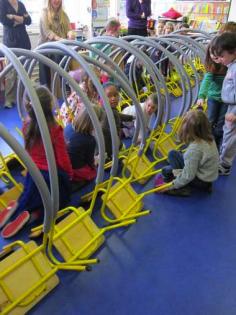
As always some of the children were more reticent than others to express opinions and adult intervention was needed to facilitate their voices being heard. This was a very important aspect of the creative process in the classroom because left to their own devices the more vocal children would have taken control and the quieter children would have remained unheard. With gentle encouragement from artist and teacher the children began to realise that everyone’s ideas would be listened to. As they became more familiar with the process, the children actively encouraged each other to express themselves.
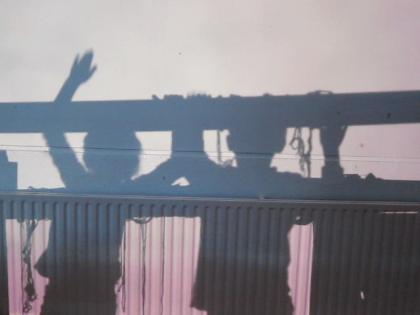
A breakthrough session, for me, was one which involved the class being split up into groups to create tent like structures. The children set to work immediately, each doing their own thing, adding material at hoc. Over the course of the session, they began arguing over the overall aesthetic of their various ’tents’. Looking on and intervening at times, I thought that this session was not working at all. To me the children seemed frustrated with each other and disappointed when everyone did not agree with what they proposed to do.
However, at the end, when each structure was in place they were thrilled with their pieces, some even hugging each other with delight! We sat down in the middle of room and they began saying how much they enjoyed the work they had just done. They spoke about each other’s ideas and it became abundantly clear that my adult interpretation of the situation was very wrong! Their interactions, albeit heated and volatile at times, had been utterly enjoyable to them.
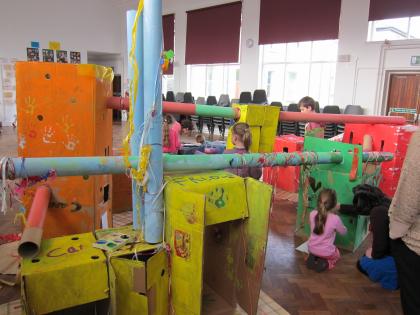
One child in particular, with quite a restricted vocabulary, seemed to blossom at that particular session. She happily described what she had done, what her friends had suggested and what ideas had been used. Her oral communication skills continued to develop greatly throughout the rest of the project as did her social interaction skills. This was the case for all the children in the class, bar one. The one child who found the collaborative aspect of the creative process very difficult is a child who is a lot more emotionally immature than his peers. He still benefited from the artistic process because he really loved any activity where he could work by himself. In a practical way, he developed his fine motor skills and concentration levels. The creative process really helped develop so many skills but I think their social interactions benefited most. It was wonderful to see all the children discuss, negotiate, compromise and work together.
What are the key elements for a successful collaboration in the classroom?
The key elements are understanding, respect, planning, preparation and communication.
The teacher must have an understanding of the artist’s vision of the project. If they are unclear about anything they must ask questions and express any doubts or reservations they have and specify any aspects they feel will work well. The teacher has care of duty to the children and is responsible for curricular and health and safety issues. The teacher know the class best and can offer information about the children’s needs, abilities and personalities. She or he must respect the fact that, for the most part, an artist is coming from a very different work environment and likewise the artist must understand and respect the classroom environment. The children’s day is always well structured, food and lunch times being of paramount importance! Children are used to routine and must be consulted, as must the teacher if timetables etc. are to be changed.
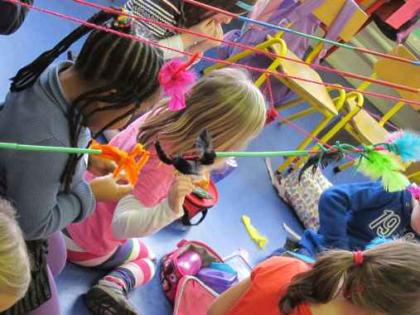
Once everyone is clear about the expectations of each session, communication is fundamental for the success of the collaboration. In our case, the children were the driving force and the artist facilitated their ideas. Helen must be commended for the level of attention she paid to the children’s opinions and then for the level of planning and preparation she put into every session. A huge part of the primary classroom is preparation of materials, be it for Maths, the Arts, Science etc. Helen arrived every time with materials enough for every child.
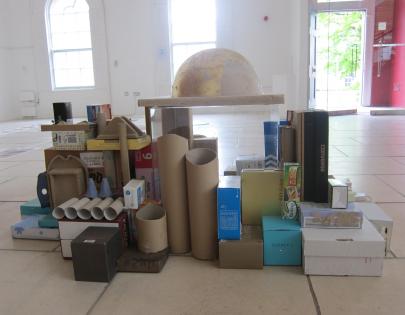
’On Site’ - artwork created by Helen Barry in the studio in response to the collaboration


No comments added